#Eileen Lebow
Explore tagged Tumblr posts
Text


By Rachel Hartigan
Published: 9 March 2023
The history of the first women who flew is a tale of breathtaking bravery and lives cut tragically short.
On 8 March 1910 — 113 years ago today — Raymonde de Laroche, a former Parisian stage actress, became the first licensed female pilot in the world.
Nine years later, she was killed when the experimental aircraft she was flying dove into the ground.
Harriet Quimby, a well-known journalist, became the first American woman to obtain a pilot’s license in 1911.
She died a year later when her new plane pitched her into Boston Harbor.
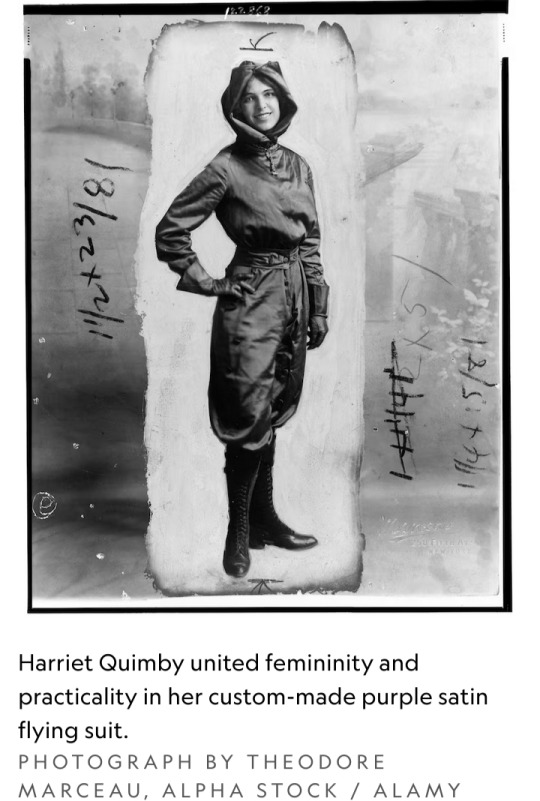
In 1921, Bessie Coleman was the first Black woman to receive a pilot’s license — she had to travel to France to find a flight school that would teach her.
But five years later, she was killed when a wrench got caught in her plane’s controls, sending the plane plummeting.

Flying was perilous in aviation’s earliest days.
"The planes were flimsy contraptions fashioned from bamboo, wire and fabric,” according to the late historian Eileen Lebow.
They didn’t have seat belts or even a roof to hold the pilot should the aircraft flip over.
Yet women like Laroche, Quimby and Coleman were willing to risk their lives for the freedom that flights promised.
“Aviation was a new profession seemingly free from the gender expectations and sex typing that limited women elsewhere,” noted historian Susan Ware at the National Air and Space Museum’s inaugural Amelia Earhart Lecture in Aviation History in 2022.
“Women were getting in at the beginning.”
For many of them, the thrill of flying was intoxicating but so was the opportunity to be assessed on their own merits.
“These women wanted to be judged as human beings rather than as women,” says Ware.
Coleman especially saw flight as a path toward broader gender and racial equality.
"I knew we had no aviators, neither men nor women, and I knew the Race needed to be represented along this most important line,” she said shortly after she returned to the United States from France in 1921.
“I thought it my duty to risk my life to learn aviating and to encourage flying among men and women of the Race who are so far behind.”
Before she died, she’d planned to open a flight school that would welcome African American aviators.
Many early women fliers shared the dream that achievement in this field would lead to more independence.
As one journalist and amateur pilot wrote in 1930, “A woman who can find fulfillment in the skies will never again need to live her life in some man’s spare moments.”

Some of that independence would come from the ease of travel that aviation promised in its earliest incarnation.
Many people, including Amelia Earhart, believed at first that airplanes would become as commonly owned by families as bicycles and automobiles already had.
Other women embraced the financial independence that they thought the new field would offer.
Neta Snook, whose first solo flight was in a plane she rebuilt, made her living by offering up her plane for aerial advertising, test flying experimental aircraft, taking paying passengers up for aerial tours, and teaching beginning fliers, including Earhart.
Gladys Roy, on the other hand, earned good money as a stunt pilot, dancing the Charleston and playing tennis on the wings midflight for amazed crowds at air shows.
(Snook retired from aviation when she became pregnant in her mid-twenties and lived to be 95; Roy died at 25 when she accidentally stepped into a propeller.)
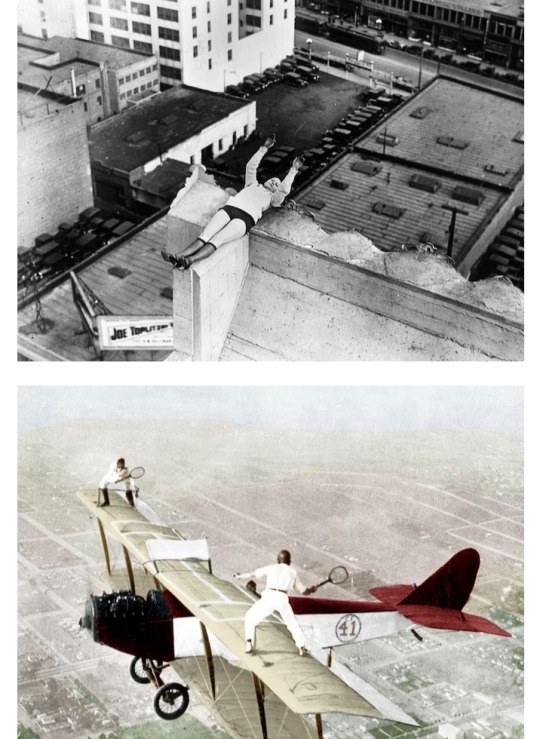

Sisters Katherine and Marjorie Stinson took a more long-term approach, establishing a flight school in Texas with their mother and brother that trained, among others, Canadian pilots in the run up to World War I.
When the U.S. entered the war, the country’s civil aviation — including the Stinson School for Flying — was shut down.
Katherine went to Europe to serve as an ambulance driver while Marjorie became an aeronautical draftsman for the Navy.
War and the development of commercial aviation conspired to dampen women’s hopes of equality in the air.
Experienced women pilots such as LaRoche and Katherine Stinson volunteered to serve in their countries’ nascent air forces during World War I.
They were denied, the military preferring to train unseasoned men.
The same pattern occurred in World War II, although Women’s Airforce Service Pilots (WASPs) did ferry U.S. military planes as civilian pilots during the conflict.
(The Soviet Union, however, had three female air combat regiments.)
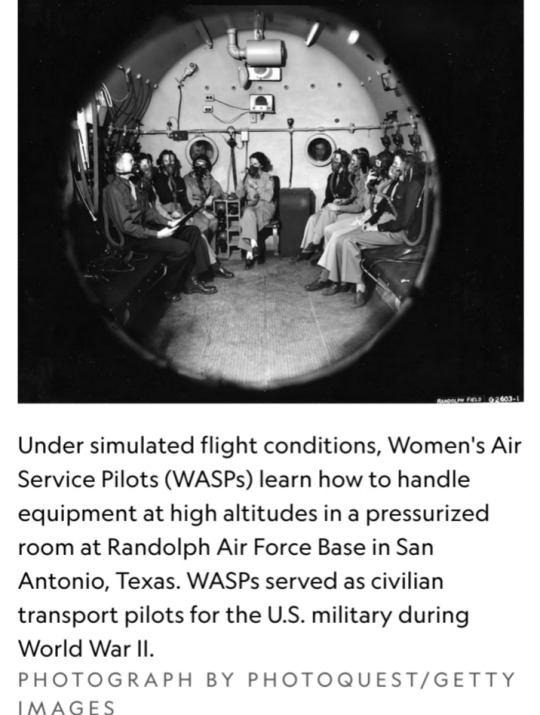
The dream of every family owning a private plane never did materialize; the infrastructure required would have been too extensive.
Instead, the commercial aviation industry developed, hiring men — many of whom had been trained as pilots by the military.
It was no use pointing out, as Earhart did, that "if women had access to the training and equipment men had we could certainly do as well."
Helen Richey became the first female commercial pilot in 1934 but was hounded out of her job.
The U.S. Commerce Department, under pressure from the all-male pilots’ union, decreed that women weren’t allowed to fly scheduled routes in bad weather.
(They’d previously considered “grounding female pilots for nine days a month during menstruation,” according to Ware).
There wouldn’t be another female commercial pilot until 1973, when Emily Howell Warner was hired by Frontier.
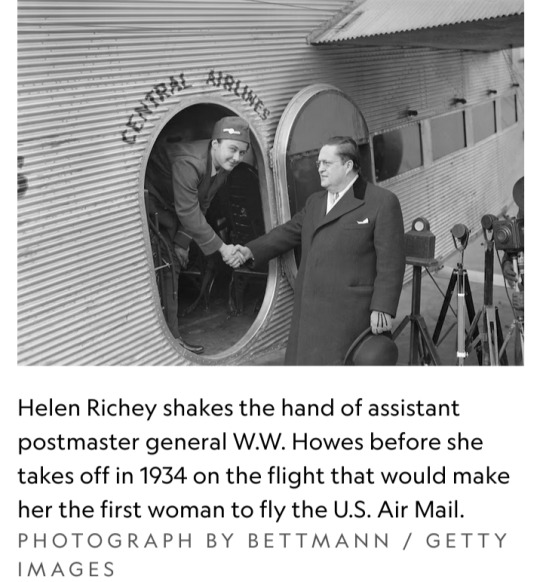
#Raymonde de Laroche#Harriet Quimby#Bessie Coleman#Eileen Lebow#Susan Ware#National Air and Space Museum#Amelia Earhart#Neta Snook#Gladys Roy#Katherine and Marjorie Stinson#Women’s Airforce Service Pilots (WASPs)#Helen Richey#Emily Howell Warner#female pilot#International Women's Day#International Women's Month#National Geographic#Nat Geo
54 notes
·
View notes
Text
Meet The Women Who Risked Everything To Be The First To Fly
As one female pilot wrote, "A woman who can find fulfillment in the skies will never again need to live her life in some man's spare moments."
— By Rachel Hartigan | March 8, 2023
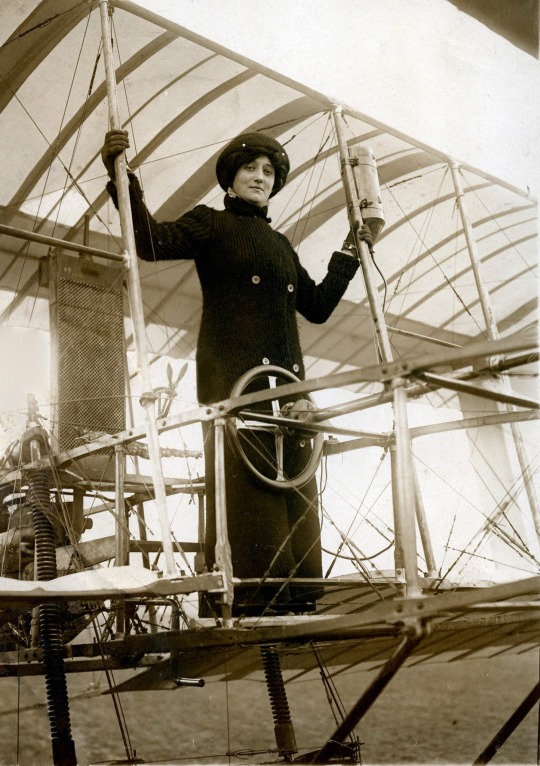
Known as la femme-oiseau (the bird woman) in the French press, Raymonde Laroche became the first woman to receive a pilot's license on March 8, 1910. She volunteered to fly for the French military during World War I but was refused because of her gender. Photograph By Chris Hellier/Corbis via Getty Images
The history of the first women who flew is a tale of breathtaking bravery and lives cut tragically short.
On March 8, 1910—113 years ago today—Raymonde de Laroche, a former Parisian stage actress, became the first licensed female pilot in the world. Nine years later she was killed when the experimental aircraft she was flying dove into the ground.
Harriet Quimby, a well-known journalist, became the first American woman to obtain a pilot’s license in 1911. She died a year later when her new plane pitched her into Boston Harbor.

Harriet Quimby united femininity and practicality in her custom-made purple satin flying suit. Photograph By Theodore Marceau, Alpha Stock/Alamo
In 1921, Bessie Coleman was the first Black woman to receive a pilot’s license—she had to travel to France to find a flight school that would teach her. But five years later she was killed when a wrench got caught in her plane’s controls, sending the plane plummeting.
Flying was perilous in aviation’s earliest days. The planes were “flimsy contraptions fashioned from bamboo, wire, and fabric,” according to the late historian Eileen Lebow. They didn’t have seat belts or even a roof to hold the pilot should the aircraft flip over. Yet women like Laroche, Quimby, and Coleman were willing to risk their lives for the freedom that flights promised.
“Aviation was a new profession seemingly free from the gender expectations and sex typing that limited women elsewhere,” noted historian Susan Ware at the National Air and Space Museum’s inaugural Amelia Earhart Lecture in Aviation History in 2022. “Women were getting in at the beginning.”
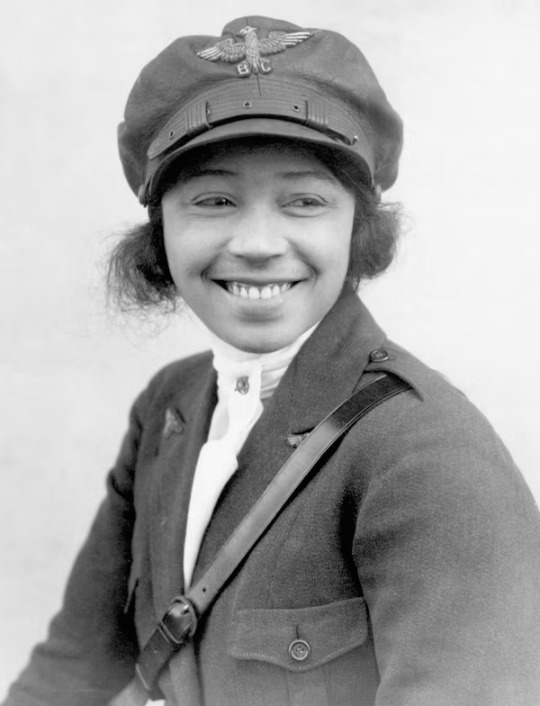
Bessie Coleman, the first Black woman flier, learned French so she could take flying lessons in Europe after no one would teach her in the United States. Photograph By George Rinhart/Corbis, Getty Images
For many of them the thrill of flying was intoxicating but so was the opportunity to be assessed on their own merits. “These women wanted to be judged as human beings rather than as women,” says Ware.
Coleman especially saw flight as a path toward broader gender and racial equality. "I knew we had no aviators, neither men nor women, and I knew the Race needed to be represented along this most important line,” she said shortly after she returned to the United States from France in 1921. “I thought it my duty to risk my life to learn aviating and to encourage flying among men and women of the Race who are so far behind.” Before she died, she’d planned to open a flight school that would welcome African American aviators.
Many early women fliers shared the dream that achievement in this field would lead to more independence. As one journalist and amateur pilot wrote in 1930, “A woman who can find fulfillment in the skies will never again need to live her life in some man’s spare moments.”
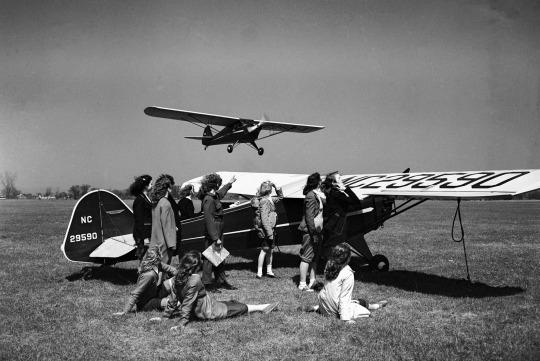
The women of Smith College Flying Club, founded in 1934, are seen here learning every aspect of airplane maintenance, flying instruction, and flight logging management. Photograph By George Woodruff, Bettmann Archive/Getty Images
Some of that independence would come from the ease of travel that aviation promised in its earliest incarnation. Many people, including Amelia Earhart, believed at first that airplanes would become as commonly owned by families as bicycles and automobiles already had.
Other women embraced the financial independence that they thought the new field would offer. Neta Snook, whose first solo flight was in a plane she rebuilt, made her living by offering up her plane for aerial advertising, test flying experimental aircraft, taking paying passengers up for aerial tours, and teaching beginning fliers, including Earhart. Gladys Roy, on the other hand, earned good money as a stunt pilot, dancing the Charleston and playing tennis on the wings midflight for amazed crowds at air shows. (Snook retired from aviation when she became pregnant in her mid-twenties and lived to be 95; Roy died at 25 when she accidentally stepped into a propeller.)
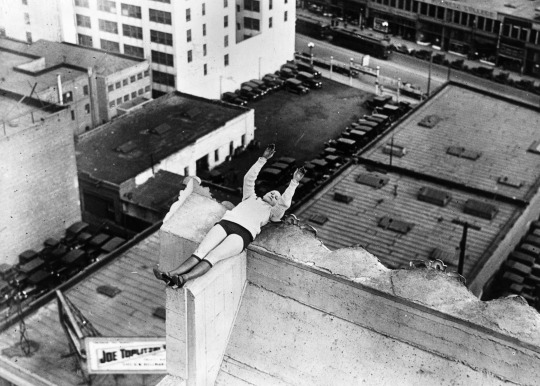

Daredevil aviatrix Gladys Roy (left) trains for her flying acrobatics by balancing on the rooftop of a building in Los Angeles. In a 1925 stunt, she played tennis against Ivan Unger on a flying plane. Photograph By Topical Press Agency/Getty Images (Left) and Photograph By Apic/Getty Images (Right)
Sisters Katherine and Marjorie Stinson took a more long-term approach, establishing a flight school in Texas with their mother and brother that trained, among others, Canadian pilots in the run up to World War I. When the U.S. entered the war, the country’s civil aviation—including the Stinson School for Flying—was shut down. Katherine went to Europe to serve as an ambulance driver while Marjorie became an aeronautical draftsman for the Navy.
War and the development of commercial aviation conspired to dampen women’s hopes of equality in the air. Experienced women pilots such as LaRoche and Katherine Stinson volunteered to serve in their countries’ nascent air forces during World War I. They were denied, the military preferring to train unseasoned men. The same pattern occurred in World War II, although Women’s Airforce Service Pilots (WASPs) did ferry U.S. military planes as civilian pilots during the conflict. (The Soviet Union, however, had three female air combat regiments.)
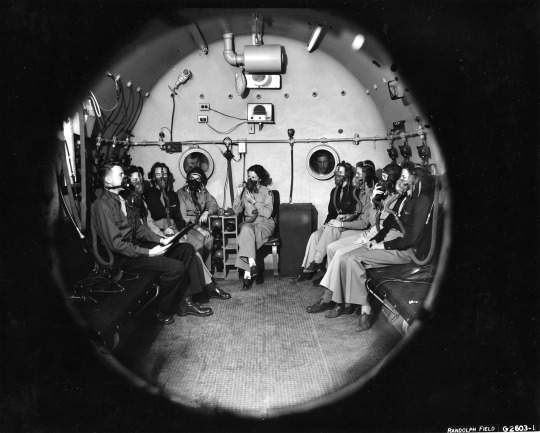
Under simulated flight conditions, Women's Air Service Pilots (WASPs) learn how to handle equipment at high altitudes in a pressurized room at Randolph Air Force Base in San Antonio, Texas. WASPs served as civilian transport pilots for the U.S. military during World War II. Photograph By Photoquest/Getty Images
The dream of every family owning a private plane never did materialize; the infrastructure required would have been too extensive. Instead, the commercial aviation industry developed, hiring men—many of whom had been trained as pilots by the military. It was no use pointing out, as Earhart did, that if women "had access to the training and equipment men had we could certainly do as well."
Helen Richey became the first female commercial pilot in 1934 but was hounded out of her job. The U.S. Commerce Department, under pressure from the all-male pilots’ union, decreed that women weren’t allowed to fly scheduled routes in bad weather (they’d previously considered “grounding female pilots for nine days a month during menstruation,” according to Ware).
There wouldn’t be another female commercial pilot until 1973, when Emily Howell Warner was hired by Frontier.

Helen Richey shakes the hand of assistant postmaster general W.W. Howes before she takes off in 1934 on the flight that would make her the first woman to fly the U.S. Air Mail. Photograph By Bettmann/Getty Images
2 notes
·
View notes
Text
Before Amelia : Women Pilots in the Early Days of Aviation (ExLib)
Before Amelia : Women Pilots within the Early Days of Aviation by Eileen F. Lebow
A copy that has been read, but is still in wonderful situation. Pages are intact and aren’t marred by notes or highlighting, but may comprise a neat previous owner name. The spine is still undamaged. An ex-library book and might have regular library stamps and/or stickers. At ThriftBooks, our motto is: Read Extra, Spend Much less.
The post Before Amelia : Women Pilots in the Early Days of Aviation (ExLib) appeared first on The best deals on the web delivered around the world!.
from Products | The best deals on the web delivered around the world! https://ift.tt/2MkLYp4 via https://ift.tt/2JJkuJC
0 notes